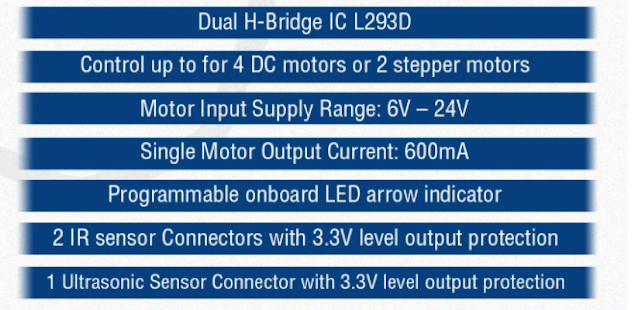One of the basics of robotics is motor control. In many projects, you'll need to use a certain type of circuitry to regulate the motor's speed or direction. You may use one of two approaches: build your own motor controller (an H-Bridge) or buy an off-the-shelf option. Buying an IC or a module that handles motor control eliminates a lot of physical work, which is why we've examined some of the finest motor & servo drivers available right now online. These are the top MotorDrivers for Raspberry Pi available on the market right now for those interested in a Raspberry Pi board and also covered motor & Servo driver for BBC micro:bit
Motor & Servo Driver’s for Raspberry Pi
Motorshield for Raspberry Pi – SB Components
Motorshield for Raspberry Pi: The Motor shield was created to assist you in building your
Raspberry Pi-based Robot. This board has the ability to control both the DC and
stepper motors. You may use your IR and Ultrasonic sensors to provide
information to your robot about its surroundings. Line Following, Object
Following, Wall Following, and Maze-Solver Robots are all simple to create.
 |
Servo Driver HAT for Raspberry Pi – SB Components
Servo Driver HAT for Raspberry Pi: This 16 Channel 12-bit Servo Driver - I2C Interface Module,
Servo Driver HAT for Raspberry Pi can control up to 16 servos at once. The
microcontroller's low PWM yields will be a major problem if you're creating a
robot with a lot of moving parts or if you need to monitor a lot of Servo
motors with PWM yields. Obtaining a 16-Channel 12-Bit PWM/Servo Driver is the
most crucial thing you can do to address this problem. With only two pins, you
can power 16 free-running Servo motors with the 16-Channel 12-Bit PWM/Servo
Driver. Up to 992 PWM outputs can be powered by connecting 62 breakouts. It's
an I2C-powered PWM driver with an assumed clock.
 |
Motor Driver HAT for Raspberry Pi
Motor Driver HAT for Raspberry Pi: The Raspberry Pi Motor Driver HAT is a device that uses I2C
communication to drive two DC motors at the same time. It features a
sophisticated onboard processor, the PCA9685 that allows you to control the
motor speed using 12-bit hardware PWM. With the motor driver TB6612FNG, the
logic voltage is 3.3 V. It may be powered by a battery via the VIN terminal,
providing a better user experience.
 |
Pico Motor Driver HAT
Pico Motor Driver HAT:
The Pico motor Motor Driver HAT is a DC motor control module driven by a single
H-bridge IC L293D with a motor input supply range of 6 V to 12 V. It is
designed to link two DC motors or one stepper motor at the same time, allowing
the user to create projects with a small footprint and great efficiency. Line
following, object following, wall following, and Maze-Solver robots are all
simple to create. It comes with a standard stackable Pico header and a motor
supply screw connector.
 |
Motor & Servo Driver’s for BBC microbit Board
Motor Driver for micro:bit
Motor Driver for micro:bit: The micro:bit Motor Driver can interact with up to two DC motors
and three pwm-based Servo motors. It operates on a 6V-12V (VIN terminal) motor
power supply with a 3A output current and a strong inbuilt TB6612FNG Module IC
that ramps up the performance. The VIN terminal may be used to supply power to
the micro:bit motor driver.
 |
Servo Driver for micro:bit
Servo Driver for micro:bit: Through the I2C interface, the 16 Channel servo driver for
micro:bit allows you to monitor 16 servo motors with 12-bit precision per
channel. The USB connection may provide 5 volts, while the screw link VIN can
provide 6 to 12 volts.
This board has a 5V voltage regulator capable of delivering
up to 3A of current. It features I2C control pins, which may be connected to
other control boards. It's simple to operate and works with the vast majority
of servos on the market.
 |
Posts You May like:
- Tiny Round/Circular LCD Display Launched!
- Issue Fixed! USB Boot Ubuntu Server 20.04 on Raspberry Pi 4
- HC-SR04 Sensor with micro-ROS on the Raspberry Pi Pico
- Raspberry Pi Pico: ADC Sampling and FFT
- Using CircuitPython for RP2040
- How to Setup Pico RP2040 on Windows
- Using micro-ROS on the Raspberry Pi Pico
- LED Tricks Using The Raspberry Pi Pico
- The RP2040 Raspberry Pi Pico Meets LoRa
- Pico supports SD cards and FatFS
- How to connect a Raspberry Pi Pico to LoRaWAN
- 50 Raspberry Pi Hacks & Tips You Should Know
- How to Install Wi-Fi and Internet on a Raspberry Pi Pico
- Easiest Way to to Run DC Motor with Raspberry Pi Pico
- Drag-and-Drop Programming For The Raspberry Pi Pico
- Make Pico DIY Project Without Any Soldering or Breadboard
- Detailed Comparison of Arduino Nano RP2040 Connect Vs Raspberry Pi Pico
- Make a USB Microphone Using the Raspberry Pi Pico
- The RP2040 is Now Available for $1
- Pico LoRa Expansion is Finally Out! Supports 868MHz
- CircuitPython 6.3.0 is Now Available with Improvement & Fixes
- Pico DIY Projects! Must Try 17 Different Pico HATs & Expansions

















.png)





